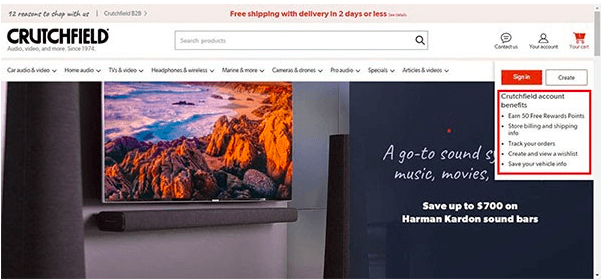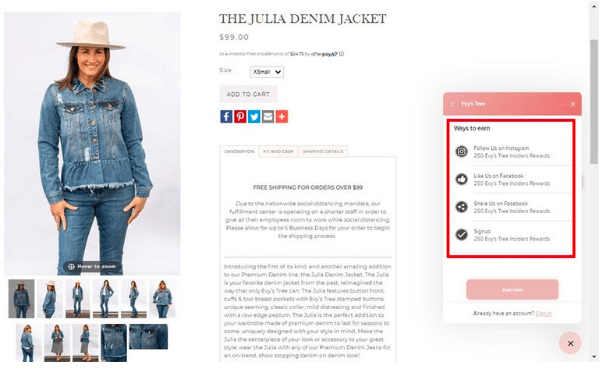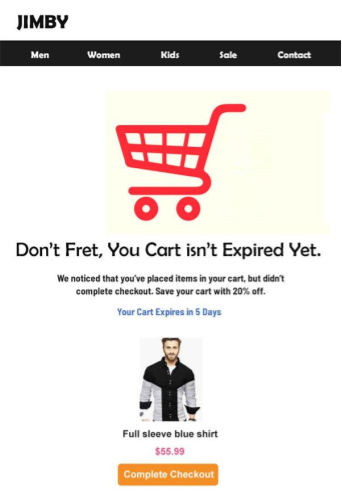Cart Abandonment Strategies: 6 Ways to Fine-tune Your Cart Recovery Approach
- 02 July 2021
This article was created in collaboration with targetbay.com.
Cart abandonment is an obvious scenario when it comes to eCommerce. It happens very often and it has now become a part of the consumer purchase journey. There is no amount of over-exaggeration in that statement considering the fact that 3 out of every 4 people who add something to their cart leave without completing the transaction.
However, as part of being mindful of the biggest leaks in their sales, many retailers have made abandonment reduction a primary goal and are devoting more and more resources towards achieving it. Even so, most online retailers’ approach toward cart recovery lacks clarity and understanding.
For instance, how many of them look closely enough to differentiate between checkout abandonment and cart abandonment? It may seem like a little thing, but that little thing can make a big difference.
This is the reason why we believe that having a clear-cut grasp of cart abandonment benchmarks, reasons that lead to it, and must-haves of creating an abandoned cart email—is necessary before jumping headlong into advanced abandoned cart email practices.
Understanding Shopping Cart Abandonment
The X, Y, and Z generation consumers—tech-savvy shoppers—are transforming digital retail. They are well-informed, data-driven, and constantly chasing better deals.
This section covers a wide range of cart abandonment statistics, the reasons why shoppers fail to complete their purchases and more.
This way, you can avoid making unnecessary mistakes, create a friction-free customer experience, and increase conversions.
Why do you need a cart recovery strategy in 2021?
Given that cart abandonment is a huge problem for marketers, we’ve collected a list of 33 shopping cart abandonment stats and broke each in detail to provide you with a quick overview of
- E-Commerce Brands Lose $18 Billion in Sales Revenue Each Year Because of Cart Abandonment.
- Only 2.86% of eCommerce website visits convert into a purchase.
- On average, 74.58% of online retail orders are abandoned, while the travel (81.31%) and airline (87.87%) sectors are the hardest hit.
- On average, 74.58% of online retail orders are abandoned, while the travel (81.31%) and airline (87.87%) sectors are the hardest hit.
- 81% of shoppers aged 18-65 had dropped out on a purchase at least once.
- 28.3% of all eCommerce revenue comes from successful abandoned cart emails.
- Over 40% of cart abandonment emails are opened.
- Abandoned cart emails achieve a 4.64% conversion rate.
- 21% of received emails for abandoned carts are clicked on.
- 10.7% of received emails for abandoned carts lead to shopping cart recovery.
Why do shoppers abandon their online carts?

How do abandoned cart emails work, and why are they so effective?
Unlike other transactional emails, an abandoned cart email has a tough task to achieve. The message has to be persuasive enough to get the attention but should also provide value to the recipients.
Now, if you are not aware, abandoned cart email campaigns are the epitome of behavior-based email marketing. They are a special breed of email messages triggered based on particular user behavior.
To be more clear, let’s say a shopper—we’ll call her Randy—is browsing your online store. Here’s how an abandoned cart email would trigger:
- Randy arrives on your website.
- She inputs her email (through an exit-intent popup, through your chatbot, while she creates an account, as she checks out, etc.).
- The email marketing tool you use (assuming that you’re already using one) identifies her as a shopper and records it.
- Randy browses your website and places things in her cart.
- She abandons the transaction without making a purchase.
- The cart abandonment behavior triggers the first abandoned cart email to send at your scheduled time. Randy receives it in the inbox of the email she submitted on your website.
- If your abandoned cart email is part of a larger sequence, Randy will receive any other emails you’ve created and scheduled.
- Reminded of the products that she left in the shopping cart to buy the products, Randy returns to your website and completes her purchase.
There it is. That’s how abandoned cart emails work. Now, let’s get into why they work so effectively.
First, here’s the answer to the question: Are abandoned cart emails really effective? Well, the numbers don’t lie.
Triggered emails—including abandoned cart emails—achieve more open rates and greater revenue. They also have significantly more endurance than any other average email, with nearly a quarter of engagement happening over 24 hours after the first send and almost 3% happening at 2 weeks.
So, what makes abandoned cart emails special?
Abandoned cart emails are tailored to address each individual recipient’s pain points. Unlike the spray-and-pray approach, they’re triggered based on shoppers’ browsing behavior and are strategically sent after each recipient’s shopping trip.
Above all, it includes items they were browsing or considering buying, making them more relevant to the recipient.
Your abandoned cart emails will only be as successful as their relevance to each recipient. What motivates an existing customer who has abandoned a high-value item in their cart is probably different than what might motivate a first-time user.
6 Cart Abandonment Best Practices Every Marketer Should Know
Now that we understand how effective these campaigns can be, let’s check out some different strategies for your campaign and ways to optimize it for increased ROI.
1. Encourage account registration by promoting members-only incentives.
One of the hardest aspects of email marketing is convincing the users to share their personal information with you. The customers are not to be blamed here, especially when considering all the recent incidents of cyber crimes and data breaches.
While displaying trust signals to build credibility and help customers feel more secure—is the classic solution preferred by most marketers, there is another way to approach this—incentivizing those who offer their email or other basic data.
When it comes to online shopping, there aren’t many opportunities to collect shoppers’ personal information. Getting customers to register an account before completing the transaction is one of the popular ways to achieve this goal.
However, forcing a user to create an account has adverse impacts on the shopping experience.
Multiple studies have revealed that 14% of customers abandon their carts if they don’t have a guest checkout option in order to purchase a product.
To skirt the issue, many eCommerce marketers choose to enable guest checkout. But by doing so, they neglect all the benefits of having customers register:
- Tracking purchase history
- Recommending products based on previous purchases
- Creating customer behavioral profiles
- Receiving feedback
- Building engagement
The good news is, there are better ways to encourage customers to create an account. People love to save or to get things for free.
Tap into that same psychological drive by offering an incentive to your customers.

Crutchfield.com offers bonus rewards when you create an account. Something is Better Than Nothing.
By creating a loyalty program similar to this, you can allow the customers to rack up points toward something else they really want.
This way, your customers are incentivized to register so they can gather and spend points and get access to coupons, free shipping, or exclusive contests that are available for members only.
2. Tackle unexpected checkout costs with unexpected rewards
When Baymard Institute conducted in-depth research to determine the number one reason that triggers cart abandonment, 55% of their survey respondents cited unexpected or extra costs as being the reason why they abandoned the cart.
This indicates that shoppers simply don’t like surprises.
To avoid such scenarios, you’ll have to make all additional costs clear before they add items to their cart.
In order to do this, you can include a shipping cost calculator in your product pages that allow the customers to calculate the estimated shipping cost before they hit the shopping cart.
While this being the most common practice to minimize the number of people who abandon your cart due to shipping costs and other charges, countervailing the surprise by unanticipated rewards is our preferred method.
You can implement this incentivized approach in two ways:
Provide free shipping: Take Amazon Prime—Amazon’s most popular loyalty program, for instance. For a $99 annual fee, Prime members can have free two-day shipping whenever they want it, all year.
Redeemable loyalty points: You can offer loyalty points for purchasing a certain product and showcase how many loyalty points or future discounts a customer can earn—on product pages or during checkout.
This gives another reason for the shoppers to complete the purchase. Here is a great example of how to reward shoppers:

Finally, a loyalty program gives customers a chance to save money. But, it’s crucial that you must communicate this opportunity in all possible ways to your customers.
In addition to embedding it into your product/checkout pages, you can use banners, exit pop-ups, or even menu points to convey this.
According to a Baymard study, as many as 58.6% of cart abandoners abandoned their carts because they were just browsing or comparison shopping.
Abandoning a virtual shopping cart, for this reason, is not about a lack of intention to buy but rather a case of searching for the best available offer on the market.
Using customer reviews or testimonials is an effective way to tackle this problem.
Shoppers often lack confidence and are less likely to complete the purchase when they visit a brand’s website for the first time. However, you can better your chances and encourage occasional visitors to complete their orders if there are enough product ratings on your site.
People don’t generally choose a brand at random; others’ opinions influence them. Consumers will almost always trust other consumers more than companies.
Here’s a statistic to back this fact up: According to the BrightLocal survey, an overwhelming 91% of customers read online reviews before making a buying decision. It follows from this that user reviews—a simple marketing tool have a huge impact on customer behavior – both positive and negative.
Let’s now find out the best ways to use social proof to improve your eCommerce sales.
- Add customer reviews to product pages: This offers a way for your customers to engage with you, as well as each other, to encourage sales.

Nike introduced user reviews at the early stages of the buyer’s journey–in an effort to establish a personal connection with their shoppers.
- Include customer testimonials in your abandoned cart emails: High-intent shoppers refer reviews to look at previous satisfied customers for validation since they found value in the same product. Social proof puts consumers at ease and makes them more receptive when you give them a nudge.

So, how do you get your customers to write genuine reviews that help close deals? How do you collect and distribute the same efficiently? Here’s how you can get customer reviews!
4. Highlight urgency and scarcity
Scarcity is a powerful psychological sales trigger that successful online retailers know how to take advantage of. Customers are afraid that something they want to buy might sell out.
Smart marketers tap into that anxiety and urge their customers to complete the transaction soon.
Offers of exclusivity or time sensitivity are the two common ways to create urgency. You can set a time limit on the discounts you offer. Doing so triggers two emotional factors: a sense of saving money and a fear of missing out.
Here’s how you should take full advantage of that scarcity effect:
You must guarantee your abandoned shoppers that you’ll hold the items for them for a definite but limited time. This way, you can encourage such shoppers to get through the checkout.

Still don’t have the foggiest notion of how effective the psychological effect of urgency is?
Studies have found that promotional or emails conveying a sense of urgency had at least 14% higher click-to-open rates, 59% higher transaction-to-click rates, and twice as high transaction rates than their average marketing emails.
5. Optimize your abandoned cart emails for mobile
With more and more consumers shopping on the go, mobile devices now drive 60% of eCommerce traffic. More email is read on Mobile than on desktop email clients.
Stats say 26% to 78% of emails are now opened on a mobile device. Another study claims that an email opened on mobile which is not mobile-friendly may be deleted within three seconds.
There are high chances that when you send someone an abandoned cart email, they first use their mobiles to check it.
And if it is not mobile responsive, you will lose a potential customer then and there.
Here’s how your email should appear on a mobile device:

To ensure your emails are fully optimized, check off everything on the list that we have shared below:
- Place the most important piece of content and call-to-action (CTA) in front and make it easy to navigate.
- Use mobile-optimized images and graphics that don’t take too long to load.
- Choose a responsive design with a single column.
- Use email-safe fonts with a good fallback font to cover up unsupported fonts and also maintain design uniformity.
- Add descriptive alt text for all the images.
- Not mandatory, but include a CTA button that follows the scroll. This might help you maintain a good recovery rate.
An increasing number of customers prefer smartphones to access their emails. Mobile email best practices give you a competitive edge and make your emails more presentable.
6. Measure your email campaign’s performance
First things first: If you aren’t still convinced, abandoned cart emails bring in the big bucks.
Customers in our data set witnessed a 38.6% drop in the shopping cart abandonment rate directly from their abandoned cart emails within just 3 months.
Having said that, the key to driving those sales is understanding and investing in strategies that seem to be working for your brand.
Like any other online marketing practice, there are multiple dimensions that your cart recovery emails’ success can be measured on: both quantitative and qualitative.
From a pure conversion standpoint, obviously, you want to know how many of your customers click-through your cart abandonment emails and complete their purchases.
The email marketing tool that you use should provide these insights, and you should also be marking all the links in your email creative with query string parameters from your analytics platform of choice.
Another conversion metric, in addition to click-through, is the email open rate. Though it’s not considered as important as CTR, many marketers like to understand how many customers opened their cart abandonment emails and later converted.
From a qualitative perspective, your campaign’s effectiveness should be measured based on insights relating to what’s causing the recipients not to convert in the first place.
Listening to customers is the initial step; taking real, actionable steps based on that feedback to create more meaningful buying experiences is the second.
It’s Your Turn!
If your e-commerce website gets a significant amount of traffic but conversions lag behind your expectations, the math is clear: you’re losing substantial revenues to abandoned carts.
More often than not, visitors who cart one or more items aren’t casual window shoppers; they have a clear intention to buy, either now or later. This is why you must make every attempt to re-engage them, thus recuperating lost revenue from these would-be sales by following up with an abandoned cart email.
What’s more, abandoned cart emails contribute to more brand loyalty, stronger customer relationships, a positive brand reputation, and more trust among customers.
Don’t miss out on this opportunity!